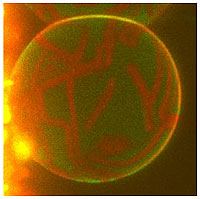This thriving area of research addresses "the physics of gloop"! Many materials, including putty, mayonnaise, hair gel and (unmentionable) biological fluids exhibit strong changes in flow and other properties response to weak external fields or stresses. This responsiveness is essential in many everyday applications and an equal number of high-tech ones (drug delivery, liquid crystal displays, sensors). Yet, in many cases, the basic physical principles linking the macroscopic behaviour to the microscopic structure remain poorly understood. One unifying theme is the presence of mesoscopic objects (polymers, colloids, cells, domains) at a scale where physics, rather than molecular chemistry, controls the behaviour. Mastery of this unexplained physics will bring new ways of controlling soft materials across a wide range of applications areas.
This work is now expanding upwards in length-scale to collections of "active" rather than passive objects (called "agents"), where issues range from bacterial motion to the flocking of birds; and also downwards towards the nanometre scale (see our New Nanocolloidal Materials initiative).
Within SUPA, a world leading group in Soft Condensed Matter is based in Edinburgh, with strong activity also in St Andrews and Strathclyde.
 |
A thin spherical shell made by self-assembly of a mixture of two types of biological lipid (red/green false colour contrast from fluorescence microscopy). Initially well mixed, the two types have separated into domains of an unexplained stripy structure. This represents a simple analogue of complex "raft-formation" processes thought to occur at the surface of biological cells. (Image: V. Gordon, Edinburgh.) |